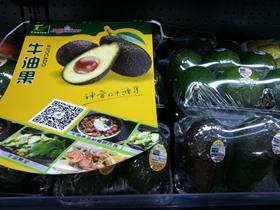
US-based marketer Mission Produce and local Chinese distributor Lantao have reported encouraging results from their joint effort to boost avocado consumption in the People’s Republic.
Prior to joining forces on their campaign, which commenced in September, the companies said in a media release that avocados were hard to find in on retail shelves in China, with only “a few token pieces of fruit” appearing in Western-owned retail stores for the expat consumer. Distribution of avocados was largely confined to the hospitality trade, where foreign chefs use them in selected hotels in the major cities such as Beijing, Shanghai and Guangzhou.
As a result, avocados remain a fairly alien product to Chinese consumers, with very few of them knowing how to open and eat the fruit, let alone understanding their nutritional value.
Recognising the huge potential for consumption of the fruit in China, however, Mission and Lantao partnered on a targeted campaign to reach out to consumers and educate them about the usage, health and nutritional benefits of avocados.
Mission Avocado was partly inspired by the successful foray of avocados into the Japanese market in the past few decades. Avocados first caught on in Japan in the 1970s with the introduction of the ‘California roll’ as a novel sushi item, and culinary usage has diversified significantly since then.
“We saw a similar situation with Japanese consumers when we entered their market,” noted Ron Araiza, vice-president of sales for Mission Produce. “Though they knew relatively little about avocados, their culture was big on gifting fruit and eating fruit for health, which is a similar environment for fruit with Chinese consumers.”
One of the key challenges the companies identified in China was getting their messages out to consumers in a country where an estimated 80 per cent of shoppers still purchase their fresh fruit and vegetables on a daily basis via the traditional markets such as fruit stands, push carts and small wet markets.
After canvassing feedback from customers, Lantao’s team learned that the best way to educate consumers was to provide point-of-purchase material to the traditional markets to help the store vendors and consumers learn nutritional information, recipes and usage tips.
John Wang, CEO of Lantao, said the company came up with a 'flag campaign', which featured a QR Code linking to its WeChat platform, whose usage is widespread among the Chinese public.
“Promotional flags were distributed with each box of fruit we sold so the fruit stands and markets could display information about avocados,” said Wang. “The flags included a QR code, which is a popular way for Chinese consumers to get information or redeem promotions and coupons.”
Lantao’s vice-president for North American sourcing Jim Provost said WeChat has 396m monthly active users in China, a rise of 40m since the end of last year.
“Consumers are introduced to our store front through the QR codes from our promotions, or are introduced by friends,” Provost said. “Lantao set up store fronts in each city we work in, so it allows for closer connection to out consumers and enables us to reach consumers in second- and even third-tier cities in China.”
When consumers place orders on Lantao’s platform, they can choose between delivery or pick up at centralised locations through a payment system that Provost described as similar to PayPal.
Mission Produce is one of the leading global players in the avocado industry, while Lantao specialises in importing high-end fresh produce from around the world to China, with distribution locations in Shanghai, Beijing, Guangzhou, Zhengzhou, Harbin, Shenyang and Qingdao.






No comments yet